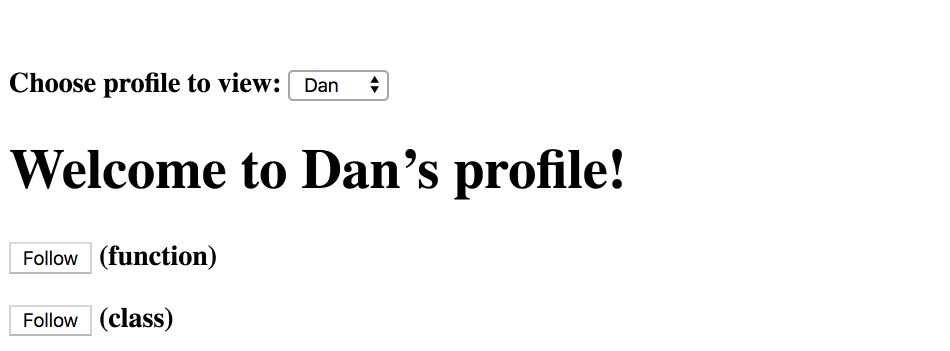# Function VS Class 组件(最大区别 - Capture Value)
function components 和 class components 之间有什么本质的区别吗?
答案就是 function components 所拥有的 捕获渲染值(Capture Value) 特性。
思维上的不同:Function Component 是更彻底的状态驱动抽象,甚至没有 Class Component 生命周期的概念,只有一个状态,而 React 负责同步到 DOM。
既然是状态同步,那么每次渲染的状态都会固化下来,这包括 state props useEffect 以及写在 Function Component 中的所有函数。
注意:下文中所描述的,全部都是在 React 中 function 和 class 的差别,差异本身和React Hooks无关。
# 什么是Capture Value
对比下面两段代码。(在线demo (opens new window))
- Class Component:
class ProfilePage extends React.Component { showMessage = () => { alert("Followed " + this.props.user); }; handleClick = () => { setTimeout(this.showMessage, 3000); }; render() { return <button onClick={this.handleClick}>Follow</button>; } } - Function Component:
function ProfilePage(props) { const showMessage = () => { alert("Followed " + props.user); }; const handleClick = () => { setTimeout(showMessage, 3000); }; return <button onClick={handleClick}>Follow</button>; }
通常认为这两段代码是等效的,然而,其实这两段代码是有细微的差别的:
尝试顺序操作:点击一个Follow按钮 -> 改变select选项然后等待3秒 -> 查看alert的文字
你会发现一个问题:
- 在function components中,在Dan的主页点击follow然后切换到Sophie,alert仍然会展示“Followed Dan”。即
Function Component展示的是修改前的值。
- 在class components中,alert的却是“Followed Sophie”。即
Class Component展示的是修改后的值。
那么 React 文档中描述的 props 不是不可变(Immutable)数据吗?为啥在运行时还会发生变化呢?
什么叫「Capture Value」特性
我们知道,在 React中,每次 Render 都有自己的 Props 与 State,可以认为每次 Render 的内容都会形成一个快照并保留下来,因此当状态变更而 Rerender 时,就形成了 N 个 Render 状态,而每个 Render 状态都拥有自己固定不变的 Props 与 State。这就是 Capture Value 特性。
不过,虽然 props 是不可变的,但在 Class Component 中使用了 this.props 来获取 props,而因为 this 是可变的,所以 this.props 的调用会导致每次都访问最新的 props。与类组件相对的,Function Component 不存在 this.props 的语法,因此 props 总是不可变的。
# 如何使class组件也有 Capture Value
拓展:如何使类组件也有 Capture Value 特性
1、之所以在类组件中使用this会失去Capture Value特性,本质上就是因为 拿到this.props太晚了,简单的方式就是更早地拿到this.props的值,然后显式的将它传递到超时处理函数中:
class ProfilePage extends React.Component {
showMessage = (user) => {
alert('Followed ' + user);
};
handleClick = () => {
const {user} = this.props;
setTimeout(() => this.showMessage(user), 3000);
};
render() {
return <button onClick={this.handleClick}>Follow</button>;
}
}
但上述方式并不解决所有问题,因为如果ShowMessage调用另一个方法,而该方法读取this.props.something或this.state.something,我们必须通过在ShowMessage调用的每个方法,将this.props和this.state作为参数传递。这破坏了class的解构,代码冗长,不易维护。
2、如果我们依赖于js的闭包,问题就会得到解决。闭包通常是被避免的,因为它很难考虑一个随时间变化的值。但是在React中,props和state应该是不可变的:
class ProfilePage extends React.Component {
render() {
// Capture the props!
const props = this.props;
// Note: we are *inside render*.
// These aren't class methods.
const showMessage = () => {
alert('Followed ' + props.user);
};
const handleClick = () => {
setTimeout(showMessage, 3000);
};
return <button onClick={handleClick}>Follow</button>;
}
}
3、上面2的方式是正确的,但看起来很奇怪。因为如果只是在render中定义函数而不是使用类方法,那么使用 class还有什么意义呢?可以直接简化点使用 function组件了呀!我们可以通过移除class来简化代码:
function ProfilePage(props) {
const showMessage = () => {
alert('Followed ' + props.user);
};
const handleClick = () => {
setTimeout(showMessage, 3000);
};
return (
<button onClick={handleClick}>Follow</button>
);
}
props仍然可以被捕获到,React将它作为一个参数传递。但 props对象本身不会因React而发生变化了。
# Capture Value 存在范围
- 每次 Render 都有自己的 Props 与 State;
- 每次 Render 都有自己的事件处理;
- 每次 Render 都有自己的 Effects(即 hooks 也有 Capture Value 特性);
# function组件如何绕过 Capture Value
利用 useRef 就可以绕过 Capture Value 的特性。可以认为 ref 在所有 Render 过程中保持着唯一引用,因此所有对 ref 的赋值或取值,拿到的都只有一个最终状态,而不会在每个 Render 间存在隔离。
